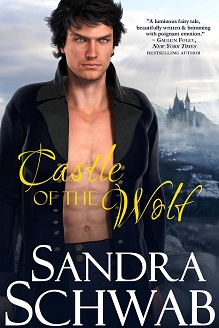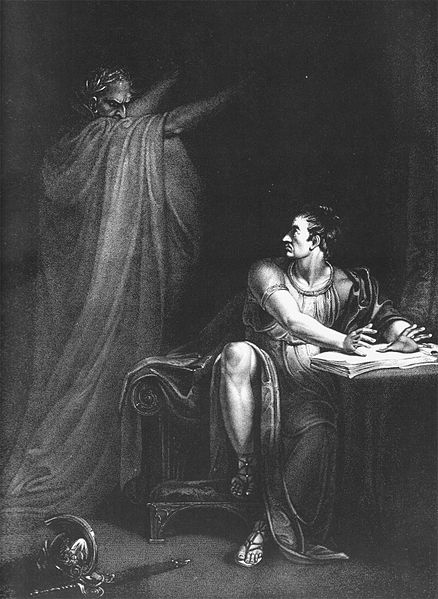There are two polls. Feel free to answer one or both or write your own in the comments.
For either poll, please imagine the love interest of your choice.
Heroine
[poll id=”21″]
Hero
[poll id=”22″]
There are two polls. Feel free to answer one or both or write your own in the comments.
For either poll, please imagine the love interest of your choice.
[poll id=”21″]
[poll id=”22″]

Last month I re-released Castle of the Wolf, a novel that was originally published back in 2007. It is a gothic romance — well, at least, it was planned as one, only then the lady with the sturdy boots turned up in the story and stomped all the gothicness to dust. Quite… eh… literally.
In the best gothic tradition, Castle isn’t set in England, but in southern Germany — in the Black Forest, to be exact, the place where I spent my primary school years and a place that is drenched in stories and covered with deep, dark woods. And quite a few castle (ruins).

The Kastelburg in Waldkirch. I spent my primary school years in this little town, & the town & castle were the inspiration for the main setting in Castle of the Wolf
Upon her father’s death, my heroine surprisingly inherits one such castle upon the condition that she marry the son of its former owner. Alas, that son turns out to be a super-grumpy dude, who does his very best to make Cissy leave the castle again. Enter rats, bats, a mouse skeleton (hey, it’s a gothic romance, there needs to be a skeleton, right?), and a bunch of very mysterious gargoyles. Oh, and there’s a very intriguing deck of (erotic transformation) cards too. In other words, my heroine has her work cut out for her if she wants to unravel the secrets of the castle.
One of the main themes of the novel is hinted at when Cissy is still in England and is packing her bags:
Cissy carefully wrapped one of her tea dresses around her copy of the Lyrical Ballads so the leather-bound volume would come to no harm in the travel chest during her journey. […]
“I cannot imagine what you want to do in Baden.” Wood creaked as her brother George shifted on the chair. “There is nothing for you there.”
There is nothing for me here. For a moment, Cissy had to close her eyes. Then she shook her head and busied herself with wrapping her book and putting it away. “I am going to have a castle.” Just imagine: a castle. Like a princess. She took up another tome.
“And marry a man you have never seen in your life.” Suddenly George sounded aggressive. “How our dear father could have come up with such a harebrained scheme is quite beyond me, I swear!”
Distracted, Cissy frowned and rubbed a thumb over a scratch in the blue leather cover of her book of German fairy tales, a present from her father for her nineteenth birthday. With her forefinger she traced the golden lettering: Kinder- und Hausmärchen gesammelt durch die Brüder Grimm.
Castle of the Wolf is a story about stories: it’s stuffed full of references to fairy tales, local legends, and to modern popular literature. While Cissy travels to the Black Forest by steamboat down the Rhine, she hears the grizly legend of the Mouse Tower of Bingen (evil bishop eaten up by mice), and later on Fenris, the grumpy hero, provides for a nice Austen / Bridget Jones moment: “For somebody called Fenris to strut around like a snarling demon wolf was just as ridiculous as, say, for somebody called Darcy to refuse to dance at an assembly.” I also couldn’t resist putting a German copy of Terry Pratchett’s Men at Arms (Helle Barden) into the castle library.
However, the most significant body of reference is formed by works of British and German Romanticism. I mean, when you have a grumpy hero and a completely exasperated heroine, you just have to reference Byron’s Byronic heroes, right? (Or rather, let the heroine reference them.) (She has never liked Byron’s Pirate and thinks Fenris’ sulking around the castle is a tad too melodramtic.) In addition, the German setting allowed me to refer to all my favorite German literary fairy tales, first and foremost Ludwig Tieck’s “Eckbert the Fair” (no happy ending, alas) with the enchanting song about woodsolitude sung by a magical bird:
Wooldsolitude,
Brings joy to me
Now and tomorrow
Forevermore,
What joy to me,
Woodsolitude.
In the course of Castle of the Wolf, Cissy also reads one of my favorite literary novels in German, E.T.A. Hoffmann’s The Life and Opinions of the Tomcat Murr. The first two volumes of the novel were published in 1819 and 20; Hoffmann died before he could begin working on the third volume. In a way, it is fitting the novel remained a fragment, for it is told in fragments: it is the autobiography of the (rather conceited) Tomcat Murr, who rips apart an older book to have paper to write on and as blotting paper. This older book is another biography, that of the bandmaster Kreisler, and at first it seems that these two stories don’t have anything to do with each other, but they become more and more intertwined. The Life and Opinions of the Tomcat Murr was clearly a writing experiment for Hoffmann, a fun project where he created something very innovative and very intriguing.
 So in other words, my own novel, Castle of the Wolf, is a declaration of love for stories and for reading and for seeing the world through the lens of fiction.
So in other words, my own novel, Castle of the Wolf, is a declaration of love for stories and for reading and for seeing the world through the lens of fiction.
If you would like to accompany Cissy on her journey to the Black Forest, grab a copy of Castle at the following retailers:
Amazon: http://www.amazon.com/dp/B01IDD8K7U/
Apple: https://itunes.apple.com/us/book/id1133885806
B&N: http://www.barnesandnoble.com/s/2940153356716
Kobo: http://store.kobobooks.com/Search/Query?fcmedia=Book&query=9783000400926
Happy reading!
Here’s a post from a few years ago, edited and recycled. It’s peach season and I’ve been eating lots of them. Yum.
Peaches have been around for a long, long time, from China to Europe via the Silk Road, to America in the seventeenth century and into commercial production here in the nineteenth century. There were peaches at Pemberley:
The next variation which their visit afforded was produced by the entrance of servants with cold meat, cake, and a variety of all the finest fruits in season; but this did not take place till after many a significant look and smile from Mrs. Annesley to Miss Darcy had been given, to remind her of her post. There was now employment for the whole party; for though they could not all talk, they could all eat; and the beautiful pyramids of grapes, nectarines, and peaches soon collected them round the table. Pride and Prejudice
Jumping backward a few centuries–people like me should take note that King John of England died in 1216, some say from overindulging in peaches at a banquet nine days before. Here’s a recipe from 1597 for Peach Marmalade.
To make drie Marmelet of Peches.
Take your Peaches and pare them and cut them from the stones, and mince them very finely and steepe them in rosewater, then straine them with rosewater through a course cloth or Strainer into your Pan that you will seethe it in, you must have to every pound of peches halfe a pound of suger finely beaten, and put it into your pan that you do boile it in, you must reserve out a good quantity to mould your cakes or prints withall, of that Suger, then set your pan on the fire, and stir it til it be thick or stiffe that your stick wil stand upright in it of it self, then take it up and lay it in a platter or charger in prety lumps as big as you wil have the mould or printes, and when it is colde print it on a faire boord with suger, and print them on a mould or what know or fashion you will, & bake in an earthen pot or pan upon the embers or in a feate cover, and keep them continually by the fire to keep them dry. The Second Part of the Good Hus-wives Jewell, (1597); Thomas Dawson. From theoldfoodie.com

Indian Blood Cling Peaches growing at Monticello
I couldn’t find a whole lot about peach recipes in England in the Regency period. There’s a possibility that quinces were more popular than peaches, according to historicfood.com (great pics here!). A lot of the historic recipes I did find were of the use them up quick variety and/or preserve them and if you’ve ever visited a pick your own orchard you’ll know exactly what I mean.
In America, were much more popular. Thomas Jefferson embraced peach cultivation with enthusiasm, growing thirty-eight varieties at Monticello, compared to only two varieties at Washington’s Mount Vernon. Jefferson made mobby, an alcoholic drink from peaches, claiming that “20 bushels of peaches will make 75 galls. of mobby, i.e. 5/12 of its bulk” (The Fruits and Fruit Trees of Monticello. Peter J. Hatch).
I’m fascinated by the wealth of varieties of peaches. Peaches are peaches, right? Unless they’re white peaches or doughnut peaches, which do have distinctive flavors. William Cobbett commented, “It is curious enough that people in general think little of the sort in the case of peaches though they are so choice in the case of apples. A peach is a peach, it seems, though I know no apples between which there is more difference than there is between different sorts of peaches.” (Quoted in Hatch, above).
Here are a couple of recipes from The Virginia Housewife by Mary Randolph, first published in 1825:
Peaches in Brandy. Get yellow soft peaches, perfectly free from defect and newly gathered, but not too ripe; place them in a pot, and cover them with cold weak lye; turn over those that float frequently, that the lye may act equally on them; at the end of an hour take them out, wipe them carefully with a soft cloth to get off the down and skin, and lay them in cold water; make a syrup as for the apricots, and proceed in the same manner, only scald the peaches more.
Peach Marmalade. Take the ripest soft peaches, (the yellow ones make the prettiest marmalade,) pare them, and take out the stones; put them in the pan with one pound of dry light coloured brown sugar to, two of peaches: when they are juicy, they do not require water: with a silver or wooden spoon, chop them with the sugar; continue to do this, and let them boil gently till they are a transparent pulp, that will be a jelly when cold. Puffs made of this marmalade are very delicious.
And here’s a Peach Pudding recipe from later in the century, adapted from Recipes Tried and True, compiled by the Ladies’ Aid Society of the First Presbyterian Church, Marion, Ohio, 1894.
peaches, cooked and sweetened
pint sweet milk
4 eggs
1 cup sugar
1 Tablespoon butter
a little salt
1 teaspoon baking powder
2 cups flour
creamFill a pudding dish with peaches, cooked and sweetened; pour over them a batter made of one pint of sweet milk, four eggs, one cup of sugar, one tablespoon of butter, a little salt, one teaspoon of baking powder, and two cups of flour. Place in oven, and bake until a rich brown. Serve with cream.
The title of this post, by the way is from Andrew Marvell. I do love the phrase “stumbling on melons”, and if I’d discovered these lines sooner I might have blogged about melons:
The nectarine, and curious peach,
Into my hands themselves do reach;
Stumbling on melons, as I pass,
Ensnared with flowers, I fall on grass
What are your favorite peach recipes? Do share! I’m off downstairs where a bowl of fresh peaches awaits…
Hi everyone! I’m reposting an old History Hoydens post today, about Regency ghosts. When I wrote it, I was working on a book with a ghost character. The book is now under my bed, but who knows what the future will bring? I still think this stuff is fascinating. The block quotes are from The Haunted: a Social History of Ghosts by Owen Davies.
The character I imagined was a murder victim seeking justice (or maybe vengeance…he wasn’t entirely a nice ghost), which has been a popular kind of ghost over the centuries—so popular, in fact, that murder investigations have been opened because of ghost sightings, up through the early part of the eighteenth century. In one case in 1660, a Westmoreland magistrate investigated the death of Robert Parkin because of a report that Robert’s ghost had appeared to a man in the parish church crying “I am murdered I am murdered I am murdered.”
In 1728, a Dorset coroner exhumed a body because of several sightings of the boy’s ghost. In this case the ghost didn’t even speak—its appearance was enough to indicated foul play, despite no previous suspicion about his death. Upon examining the body, the coroner decided he had really been murdered.
Murder victims sometimes haunted their killers: a servant who had killed his master and gotten clean away to Ireland was driven to turn himself in by a headless ghost who appeared to him every night demanding “Wilt thou yet confess?” Sometimes they haunted other acquaintances.

David Garrick in his iconic “just caught sight of the Ghost” pose, 1769. Image via Wikimedia Commons.
One of the most upsetting incidents described in the book is this one:
The astrologer and occultist John Heydon (1629-c.1670) recounted how one of his mother’s maids was pulled out of her bed one night by the ghost of a lover named John Stringer, who had recently been murdered by a jealous admirer. Despite three doors leading to her bedroom being locked, the maid ‘had the right side of her haire and headclothes clean shaved or cut away’ by Stringer’s ghost.
That poor woman! Whether you believe in ghosts, or whether you think she imagined the ghost out of guilt and shaved her own hair, it’s an awful story. I hope the “jealous admirer” was prosecuted, and didn’t get to continue stalking and attacking her and her loved ones.
Sometimes ghosts appeared to strangers at the site of their hidden graves. This tied in with another ghost tradition, that souls who didn’t receive Christian burial would walk until their bodies were found and interred in consecrated ground. In 1806, in a town near Manchester, the townsfolk drained a deep pool after a recently missing man’s ghost repeatedly appeared over it at midnight, leading to suspicion he had been murdered. His body was actually found at the bottom, although the evidence indicated he had drowned accidentally. (Not…really sure what this “evidence” would have consisted of at the time. Since writing the original post I’ve read a lot about Elma Sands’s 1800 murder in New York, which also involved the body spending time in water, and there was more or less a complete lack of contemporary forensic knowledge displayed in the autopsy testimony by prominent doctors. So I guess what this really means is that the coroner’s jury ruled for accidental death.)
Francis Grose [in his 1787 A Provincial Glossary, with a Collection of Local Proverbs, and Popular Superstitions] wondered why the ghosts of those murdered did not go straight to the nearest justice of the peace, rather than hang about their burial place frightening passers-by. ‘Ghosts have undoubtedly forms and customs peculiar to themselves,’ he concluded. [Google books link for Grose]
Ghosts historically have not talked much, although apparently they talked more before the Victorian era!

“Brutus and the Ghost of Caesar.” Copperplate engraving by Edward Scriven from a painting by Richard Westall. London, 1802. Image via Wikimedia Commons.
Completely silent ghosts became the norm to a much greater extent over the course of the nineteenth century. Generally ghosts who did speak were wrong-righting ghosts. (Although there were exceptions! In 1706 Mr. Shaw, a fellow of St John’s College, Oxford, chatted with the ghost of a dead colleague for two hours before receiving his warning of untimely death.) Murder victims were the most common. (Conflicts over inheritance were also a big one: “Mother’s ghost appeared to me and she says I get the antique dining set!”)
Ebenezer Sibly, eighteenth century writer on astrology and the occult (and huge racist), insisted that only murder victims could speak (and possibly only those who had been killed in “circumstances uncommonly horrid and execrable”), because the traumatizing memory did “more powerfully operate upon the faculties of the apparition, so as to enable it to frame the similitude of a voice, so as to discover the fact, and give some leading clue to detect and punish the wicked perpetrator.”
What’s your favorite ghost story? (Either a famous one, or one that happened to you or someone you know…)
I say all the time that I’m a pantser, not a plotter, but I’ve come to realize that’s only partially true. I do plot, or at least I research towards plot. When I’m in the “thinking” phase of starting a new book, I have a go-to list of resources that I always check out to see if anything sparks.
The Annals of London
I absolutely love this book. It goes year by year from 1065 to 1999. For each year, it lists significant events and strange goings on. So stuff my characters might well have known about, talked about, been interested in, etc. Take for example 1789. There are only five entries.
How many of these might make it into my book? At least four of them. Clearly the frozen Thames and entertainments would be great (in fact, I used them in Lord Sin). The Shakespeare Gallery? Could make a useful outing or meeting place for my characters and add a little period flavor to the book. The Italian Opera House burning down? Oh, hellz yeah. Now we’re talking. Obviously I’d have to research the circumstances, but that could add drama in so many ways. Bridge opening? Yep. Another good detail to use for an outing or meeting, and you always need those (you can only write so many balls, LOL).
The English Year
This one is sort of the opposite of The Annals of London. It covers the year, day by day, with tidbits about special holidays and events. So I flip through this looking to see if anything particularly good is happening during the months when my book takes place (this sometimes helps me choose a location for a character’s seat or country home so I can use some particular tidbit. For example, this archery contest sounds like a lot of fun to write about, which might lead me to do put my characters at some kind of house party in Yorkshire so they could observe or participate.
Political Stuff
Since I’m writing about people in the ton, it’s very likely that they (or their father, or brother, or all of the above) are in Parliament as either a sitting Lord or an MP. There’s a very useful list of the Acts of Parliament on Wikipedia that can provide fodder for plot, both external and internal depending on your characters and the story. Especially in years when something huge happened. If I go look at 1788, the first thing on the list is the American Loyalists Act. That certainly sounds like it could be a plot point (albeit with a lot of research). A character fighting for almost a decade for compensation for remaining loyal to the crown? Yeah, that works. Want a do-gooder character? How about The Chimney Sweepers Act? Really want to get into it? The Slave Trade Act was also passed in 1788. It was supported by some Abolitionists and opposed by others because it merely regulated the trade. Basically, this lets me know what would have been on everyone’s mind (and what votes would have been important enough for a character to make sure he was present for the vote (something I used in Ripe for Seduction to get my secondary hero out of the way for an important plot point).
Gossip
Who was being talked about and why were they being talked about? There are all kinds of resources for this, but one of my favorites is period cartoons. So I always spend a little time looking in various museum archives for cartoons (like what would have been posted in Ackermann’s windows). I also take a peek at the biographies on my shelves that might be of interest and in books like Decency and Disorder and George III: A Life in Caricature. I definitely always look to see if anything interesting was happing with Prinny!
Sports
Because I tend to write Corinthian-type heroes, I definitely look at what was going on with various sports as well. Racing and boxing are both fairly easy to research online. And it’s always fun when there was a big scandal in one of those.
Science and the Arts
I also love to glance through The Royal Society of London Philosophical Transactions (they’re on JSTOR, which most people can access via their library). Sometimes there’s a cool tidbit (report of an earthquake felt in Manchester) or information about new astronomy discoveries or other scientific experiments. Again, this is mostly just ideas for period color and to remind myself about what people would be reading and talking about.
So there you have it, my way of easing into a new book with research. And yes, I was once told by a very prominent agent (who I have a lot of respect for) that she was not the agent for me because, and I quote, “It’s clear you really love history; sadly, I don’t mean that a compliment.”
